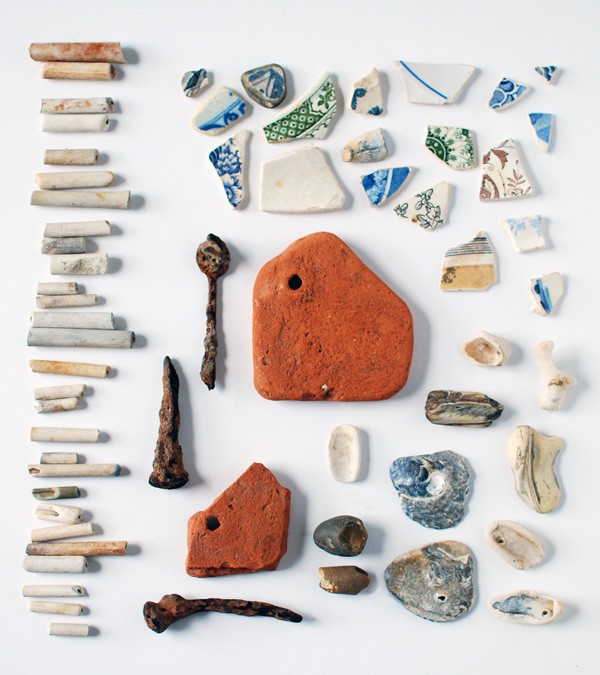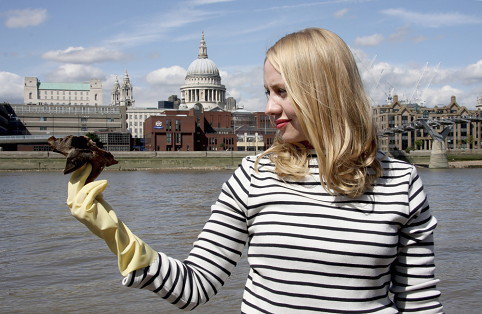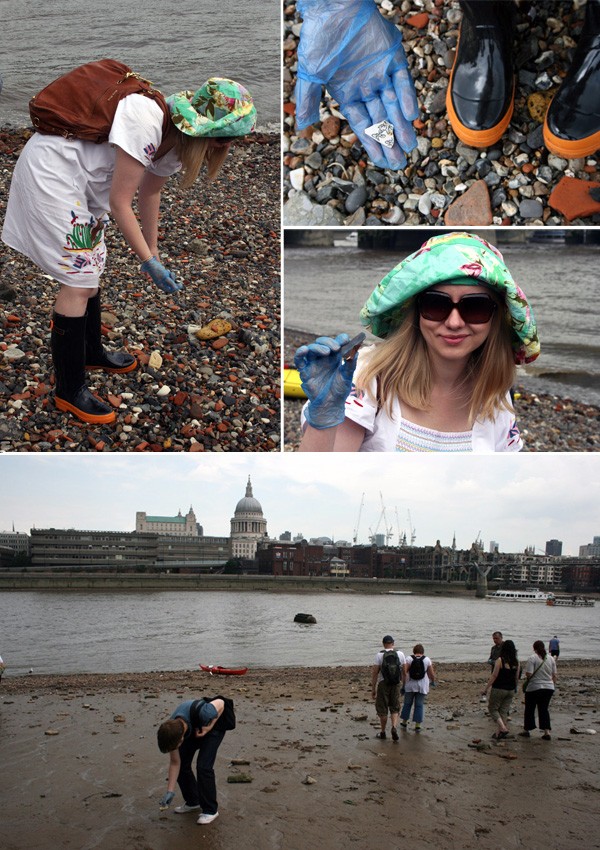My Collections: Thames Beachcombing Finds

From ’60s activist badges to ‘80s erasers to… my Thames beachcombing finds. It’s a pretty good reflection of my diverse nerdy interests.
I’m a frustrated archaeologist. I really wanted to study archaeology at university but went down the English literature route instead. When we first moved to London, I was following (mostly all-male American) metal-detecting groups online, who organised weekenders on fields all over Britain, digging for treasure. Excitement!
But when the metal-detecting thing didn’t eventuate, I started to look in my own backyard. Literally. We lived on Kingsland Road, an old Roman road which was the main route heading north out of London. I had a little dig around the garden beds in our backyard, hoping to unearth a Roman coin or two. Apparently they’re a dime a dozen in and around the City. No such luck.
But when I heard about all manner of ancient treasure that can be found on the banks of the Thames, I soon found myself Bankside one hot summer’s afternoon, one hand sheathed in latex and my feet encased in wellies.

Me, wearing rubber gloves and showcasing my latest find: a bit of old bone. Photo courtesy of Time Out London.
I had joined a tour with London Walks, led by inter-tidal archaeologist Fiona Haughey.
The remarkable thing about beachcombing that particular area of Bankside, quite literally a stone’s throw from the main tourist drag between The Globe Theatre and The Founders Arms pub, is the sheer amount of historical artefacts that can be found just on the surface of the beach rubble.
It’s little wonder, really, when you consider that the river Thames has played host to human inhabitants for thousands of years. And it goes back long before that.
There are Tudor roof tiles (look for their tell-tale peg hole; smooth top and unfinished bottom); clay pipes dating back to 1550; pieces of bone that, depending on the colour and condition, could have come from a Neolithic peat bed; Roman and Medieval oyster shells; fragments of 17th century delftware from the nearby Southwark kilns; as well as evidence of London’s maritime history from the 18th and 19th centuries.
Of course there’s every chance you could pick up a piece of cheap ceramic circa 2007, but there’s something quite thrilling about the idea that you could chance upon something quite unique – a fragment of London’s ancient history.

Just another sunny day in London… Photos by Rebecca Lowrey Boyd.
Fiona’s most exciting discovery to date, is in fact a Bronze Age human skull, which is currently housed in the carefully-controlled climes of the Museum of London.
Over the course of my own beachcombing afternoon, I eventually stumble across a rather nice slab of Tudor roof tile, an old (Roman?) oyster shell, rusty old nails, fragments of delftware, broken pieces of clay pipe, all of which can be seen in the top photo of my collection.
While my beachcombing finds hardly compare to a Bronze Age human skull, I’m completely captivated by the thrill of discovery, and I try to imagine the owner of one of the pieces of clay pipe. Who was the last person who held it in their hand, having a puff while gazing over the Thames? What was their life like? Was it a 19th century Dickensian dude? Or was it nit-ridden groundling, who popped out for a quick drag during a performance of Hamlet at the nearby Globe theatre? Who knows? That’s the exciting bit that sparks my dorky imagination.
This is an edited version of an feature story I wrote for Time Out London.
Thames Beachcombing Fast Facts
- Thinking of beachcombing the Thames? Don’t touch anything without wearing rubber gloves – you can get Weil’s disease from rat urine. Really nasty (and potentially fatal).
- Wear sensible, fully-enclosed shoes and look out for broken glass and beer bottles.
- Take a plastic bag for your finds.
- Go beachcombing at low tide only. Click here for the Thames Tide Table.
- Read up on the UK’s Portable Antiquities Scheme. To report your finds, get in touch with your local Finds Liaison Officer. They will identify and record your finds onto their database for you and others to see and researchers to study.
- Want to go Thames beachcombing with archaeologist Fiona Haughey? Click here for her schedule with London Walks. You might need to wait until she returns from her latest dig in Turkey.
- Want more info about the Thames? Head to the Thames Discovery Programme – a really brilliant resource for London enthusiasts.
- Want to see more London archaeological finds? Make a beeline to one of my favourite London haunts, the Museum of London (not to be confused with The British Museum).
Tell me: have you ever gone scouting for treasure? Beachcombing? Mudlarking? Share your nerdy finds with me in the comments below. I’d love to hear from you.
Click here to see more of our collections.
Top photography and styling by Lisa Tilse for We Are Scout.







